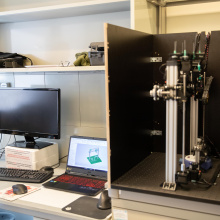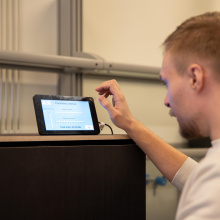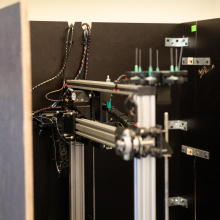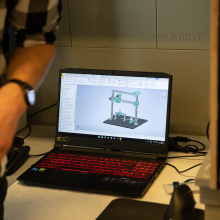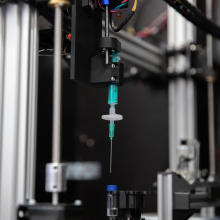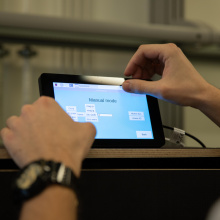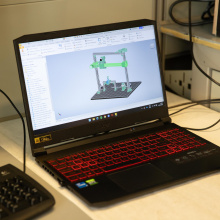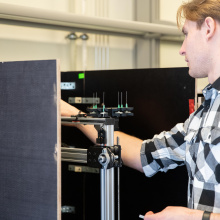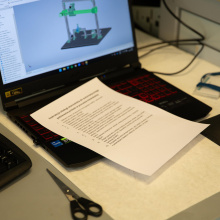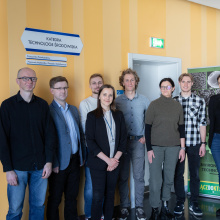The Department of Environmental Technology at the Faculty of Chemistry, University of Gdańsk has received a unique device – a sampling robot designed and built by a group of students from the Mechatronics Department of the Faculty of Mechanical Engineering and Ship Technology at the Gdańsk University of Technology in cooperation with employees of the Faculty of Chemistry, University of Gdańsk. The robot will automate the filtration of liquid phase samples and their preparation for chromatographic testing. Watch the video showing the device in action!
The robot built at the Faculty of Chemistry will not carry out analyses - it will be used to prepare samples for electrolyte analysis in photocatalytic processes. In order to store the samples, it is necessary to filter them beforehand. The robot will use a syringe with a needle to take a sample, filter it through a microfilter and place it in a test tube in a storage tank with temperature control. Ensuring thermal stability is extremely important in these tests - the use of a robot will not only automate the tedious, repetitive process, but also eliminate potential human error, e.g. in measuring the time that samples were exposed to unfavourable thermal conditions.
‘The robot will allow us to eliminate certain repetitive processes that may not be very labour-intensive, but they are time-consuming because the operator has to wait several hours to take a repetitive sample,’ says the head of the Department of Environmental Technology, prof. dr hab. inż. Adriana Zaleska-Medynska. ‘This particular robot has been designed to help us analyse the electrolyte in photocatalytic processes. We use these processes to degrade pollutants that are in the aqueous phase, but also to generate hydrogen or photocopy carbon dioxide. At this stage, the robot can only take liquid samples, but our next idea is to work together to create a robot that will take gas samples.’
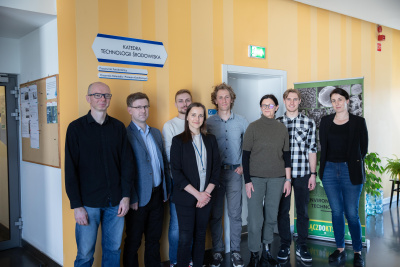
The device was designed and then built as a thesis project by three mechatronics students at the Gdańsk University of Technology: Karol Radowski, Jakub Łosiński and Jędrzej Słomiak.
‘The most important requirement of the project was that the device should work in a repetitive manner and not require human presence. Today, it is enough to set the device up and it works by itself,’ say the creators of the robot. Interestingly, some elements of the test rig were made using 3D printing. If they were to be damaged, they could be printed again based on the models created by the students.
‘They did a great job,’ said dr inż. Michał Mazur from the Mechatronics Department at GdańskTech, the thesis supervisor. ‘They designed the station themselves with the support of the Department of Environmental Technology - they put a lot of work and passion into it. In the initial stages, they visited the laboratory and observed the work of the scientists, and then translated the activities performed by the operators into individual movements that the robot could perform.’
‘The project carried out by the students was complex and required knowledge and skills in many areas of mechatronics, and, what is extremely important, it required taking into account very specific requirements of the employees of the Department of Environmental Technology at the University of Gdańsk,’ added dr hab. inż. Marek Galewski, prof. GdańskTech, head of the Mechatronics Department. ‘The students showed great commitment, learnt a lot and, in the end, were successful.’
For three of the diploma students, this was not their first joint project – they had previously worked together as part of their activities in a research club. They all emphasised the value of cooperation and division of tasks, which enabled them to complete the project faster and more effectively. The academic supervisors and scientists from the Faculty of Chemistry at the University of Gdańsk emphasised the professionalism and commitment of the students from the Gdańsk University of Technology.

